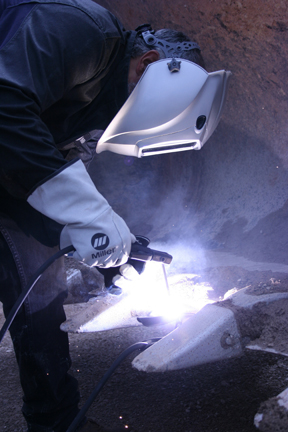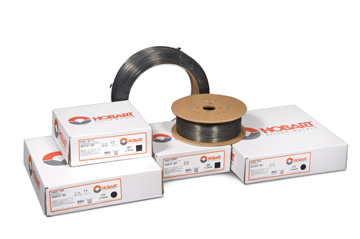Filler Metals for Equipment Repair: What to Know
Maintaining and repairing equipment can be a tedious process, especially after the equipment has seen significant jobsite abuse. Dirt, rust and day-to-day workloads can quickly wear key components, resulting in the need for any number of welding repairs. Depending on the type of wear the equipment encounters, it may be necessary to weld various joint configurations or apply hardfacing to rebuild and protect parts.

key components, resulting in the need for any number
of welding repairs.
Regardless of the maintenance and repair activity, the goals when welding are the same: to minimize downtime, extend equipment life and get back to the job faster.
To get the best results when welding for welding repairs or maintenance, it’s important to select the right filler metal for the job. That means choosing a filler metal that is compatible with the mechanical and metallurgical properties of the base metal, as well as the service requirements of the application that the equipment will encounter. Look for options to prevent cracking, particularly on highly restrained joints. In some cases, low-hydrogen filler metals may be required to mitigate the cracking risk, either singularly or in conjunction with preheating. When in doubt of the best filler metal choice, a trusted equipment manufacturer, filler metal representative and/or welding distributor can help.
There are several filler metal options for equipment maintenance and repairs, and this article will provide an overview of the common categories, along with their advantages and limitations.
Hardfacing filler metals
Hardfacing is a common welding process for maintenance and repair in which layers of welds are added to a part of the equipment (e.g. buckets or teeth) in order to extend its life and reduce costs for replacement parts. Hardfacing filler metals are typically available in stick electrodes, gas and self-shielded flux-cored wires and metal-cored wires for both build-up — to return worn parts to their original dimension — and overlay, in which layers of weld metal are added to protect against metal lost by way of wear or abrasion. There are options for various types of wear and abrasions, and select hardfacing filler metals are also suitable for joining applications.
It is important to use hardfacing filler metals only for their intended purpose. For example, an overlay filler metal should never be used for a joining application unless indicated by the filler metal manufacturer. Similarly, hardfacing products are formulated for specific base metals, so it is always important to match the base metal to the correct filler metal.
Stick electrodes
Stick electrodes are often the “go-to” filler metal for equipment maintenance and repairs. Many welding operators are familiar and comfortable with the stick welding process and these filler metals work well for welding in restricted areas where a MIG or self-shielded FCAW gun won’t fit. In addition, stick electrodes require no external shielding gas, making them very portable and lightweight, particularly for field repairs; there is no need to haul a separate shielding gas tank. Stick electrodes are available in most common alloys and for most common repair applications. From mild steel and low-hydrogen varieties to low alloy and hard surfacing products, there is usually a stick electrode for the job.
When high job site productivity is of special concern, some welding operators may choose to forgo the use of stick electrodes for equipment maintenance or repair in favor of a continuous wire process. Stick electrodes require frequent changeover as the rod burns down, generating stub loss — 1 to 3 inches of the product that must be thrown away. This unavoidable break in the process, along with lower deposition rates than other welding processes, may also make stick electrodes inefficient for larger repairs.

it’s important to select the right filler metal for the job. That means
choosing a filler metal that is compatible with the mechanical and
metallurgical properties of the base metal, as well as the service
requirements of the application that the equipment will encounter.
Flux-cored wires
Flux-cored wires are available in both gas-shielded and self-shielded varieties, many of which are tolerant to rusty or dirty materials and usable for all-position welding, making them ideal for equipment maintenance and repairs. Both wires are quite versatile and can be formulated for general-purpose use, or to have additional properties such as low hydrogen levels or good low temperature impact properties. Depending on the wire, gas-shielded flux-cored wires can use either 100 percent CO2 or a shielding gas mixture of 75 to 80 percent argon with a balance of CO2. Self-shielded flux-cored wires are designed to be used without shielding gas, so they are very portable for field maintenance and repair — they do not require gas tanks, gas hoses or regulators.
Both types of flux-cored wires can be used in the shop or field. However, when used outside, gas-shielded flux-cored wires may require the use of tents or other barriers to protect the weld pool from losing shielding gas coverage to the wind. Another limitation to using gas-shielded flux-cored wires in the field is the need to haul shielding gas cylinders to the site of the repair. In the shop, both gas-shielded and self-shielded wires may require additional ventilation due to the smoke or fume generation. And while faster than stick welding (because flux-cored welding is a continuous wire process), welding operators may still accrue downtime in between and/or after weld passes for removing the slag generated by both of these these filler metals.
Solid and metal-cored wires
Both solid wires and metal-cored wires are common for the manufacturing of construction equipment, but are used in limited instances for maintenance and repair applications. Typically, companies turn to stick electrodes or flux-cored wires first due to their familiarity for these applications.
When used for maintenance or repair applications, however, solid wires and metal-cored wires are generally confined to shop use due to the need for an external shielding gas. Solid wires can be combined with either 100 percent CO2 or an argon/CO2 shielding gas mixture, while most metal-cored wires are designed for mixed shielding gases. For repair applications, both wires are typically used only for welding in the flat or horizontal position. Both solid and metal-cored wires can be operated with minimal spatter, which can reduce the time needed to complete a weld by minimizing pre and post-weld activities such as grinding or chipping.
Metal-cored wires are especially well-suited for welding on dirty or rusty parts. These filler metals are tubular wires that feature added deoxidizers, alloys and arc stabilizers that allow them to weld through such contaminants and still produce a sound weld. Metal-cored wires also don’t produce slag (nor do solid wires) so they are easier to clean up than flux-cored products or stick electrodes, making them more efficient overall — more of the wire goes into the joint as weld metal. Metal-cored wires are also good for parts with poor fit-up because they have a wider arc cone than other wires and can bridge such gaps.
Metal-cored wires, however, cost more than solid wires or flux-cored wires. For that reason, it is necessary to weigh out the advantages of this filler metal in terms of the time savings they provide compared to the additional expense. In some cases, companies may prefer to use an alternative product if the spatter and cleanup time is of less concern.
Making the selection
When choosing the right filler metal for a maintenance or repair application on equipment, consider the location where the welding will take place (in a shop or in the field), the service condition it will encounter, power source availabilty and the skill set of the welding operator doing the job. Each of these considerations factor into making the best selection. Also, look at details such as the timeline for completing the job and required access to weld joints to determine whether a stick or continuous wire process will be necessary to meet productivity and quality demands. Consulting with a trusted welding distributor or filler metal manufacturer can help in making an informed decision.



